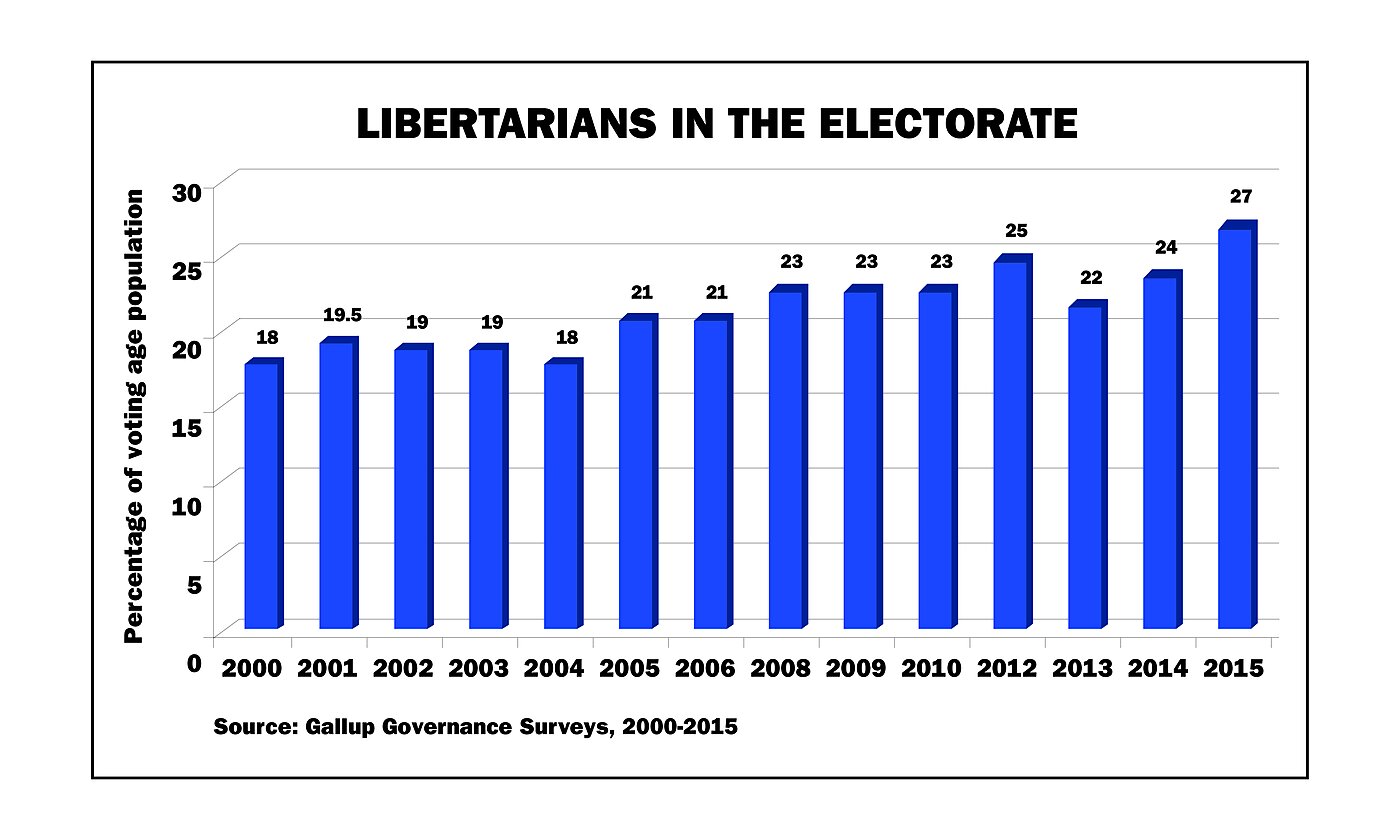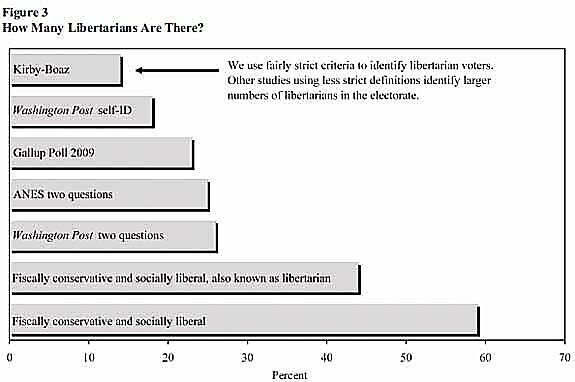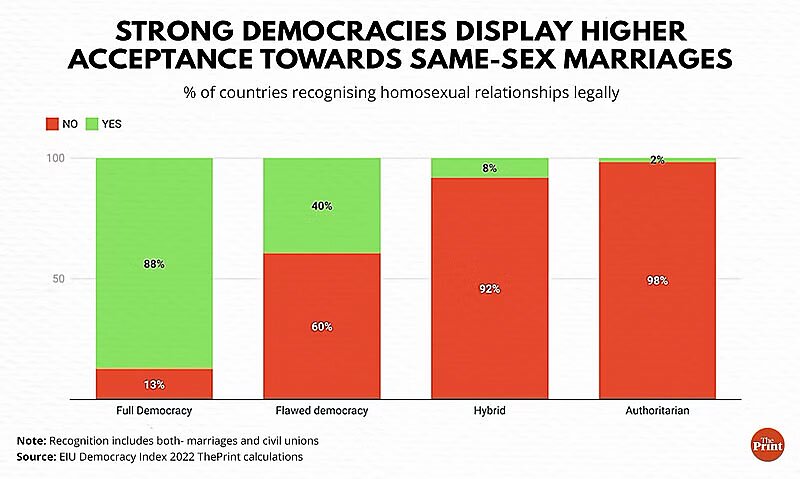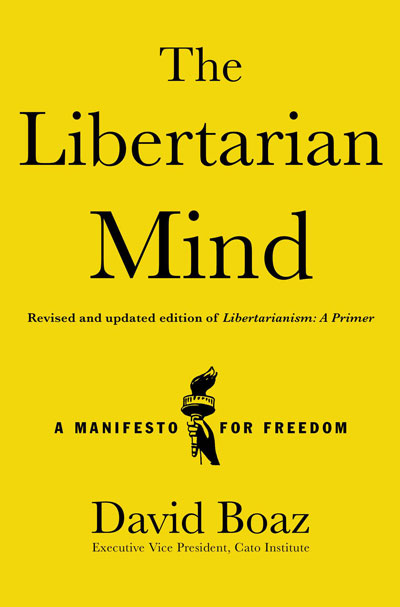The Continuing Effort to Deny that Libertarian‐ish Voters Exist
Here we go again. David Leonhardt of the New York Times dredges up a poorly designed chart from 2017 that purported to show that there are very few “fiscally conservative, socially liberal” American voters. At the time Karl Smith pointed out some basic design flaws in the analysis. Emily Ekins noted that determining the number of liberal, conservative, libertarian, and populist/communitarian/statist voters depends very much on the definitions you start with and the issues you choose. She concludes: “The overwhelming body of literature, however, using a variety of different methods and different definitions, suggests that libertarians comprise about 10–20% of the population, but may range from 7–22%.”
The Gallup Poll has regularly used a two‐question screen to divide voters into four ideological categories, and they typically found libertarians around the 20 percent mark.
Beginning in 2006 David Kirby and I used a three‐question screen to identify libertarians, and we found that with that stricter definition “libertarians” constituted about 13 percent of the population and 15 percent of reported voters. And note that if we insisted on agreement with the liberal or conservative position on all three questions, the number of liberals and conservatives would likely be quite a bit lower than 25 percent.
It’s quite possible, of course, that the Trump Effect on Republican voters, not to mention the anti‐Trump backlash among independent and Democratic voters would have significantly changed some of these pre‐Trump, “normal” findings.
We also commissioned Zogby International to ask our three American National Election Studies questions to 1,012 actual (reported) voters in the 2006 election. We asked half the sample, “Would you describe yourself as fiscally conservative and socially liberal?” — the very categorization Leonhardt used in his column. We asked the other half of the respondents, “Would you describe yourself as fiscally conservative and socially liberal, also known as libertarian?”
The results surprised us. Fully 59 percent of the respondents said “yes” to the first question. That is, by 59 to 27 percent, poll respondents said they would describe themselves as “fiscally conservative and socially liberal.”
The addition of the word “libertarian” clearly made the question more challenging. What surprised us was how small the drop‐off was. A healthy 44 percent of respondents answered “yes” to that question, accepting a self‐description as “libertarian.” We summed all that up in this handy graph:
Leonhardt and others may well be right that there are more “socially conservative, fiscally liberal” voters than “fiscally conservative, socially liberal.” Though the latter are better educated, more affluent, and more likely to vote. And in any case the numbers are a lot closer than Leonhardt and his befuddled chart would have you believe. Also, much depends on the questions you ask. Kirby and I used broad philosophical questions, as did Gallup, Pew, and ANES. But you can also use specific issues, as did a Washington Post poll. The combination “abolish Medicare” and “repeal all drug laws” would find a huge percentage of SCFL voters and very few FCSL or libertarianish voters. “Gay people should be able to get married” plus “the government spends too much money” will get you a lot of FCSL voters. Which one is closer to actual American policy conflicts?
There’s plenty of room for debate about how to analyze the ideological positions of American voters. But looking at the available data is a good place to start.
Posted on May 30, 2023 Posted to Cato@Liberty
Jimmy Lai — Recipient of the 2023 Milton Friedman Prize for Advancing Liberty
Jimmy Lai has become a powerful symbol of the struggle for democratic rights and press freedom in Hong Kong as China’s Communist Party exerts ever greater control over the territory. In prison and denied bail, Lai is an outspoken critic of the Chinese government and advocate for democracy who faces charges that could keep him in jail for the rest of his life.
Posted on May 19, 2023 Posted to Cato@Liberty
Democracies, Autocracies, and Same‐Sex Unions
A new study by the Indian newspaper The Print, based on data from The Economist Intelligence Unit’s Democracy Index 2022, finds that 88 percent of full democracies recognize same‐sex marriages or civil unions, while only 2 percent of authoritarian regimes do.
As my colleague Swaminathan Aiyar told the paper, “Autocracies do not recognise individual rights as fundamental and inalienable. Autocracies are organised on principles that allow the autocrat to discriminate on any grounds. In such countries, the progress of same‐sex rights will naturally be slower or non‐existent.” By contrast, implementation of same‐sex marriage in democratic countries proceeded very rapidly once it became a matter for debate. In 1989 Denmark became the first country in the world to legally recognize same‐sex unions, in the form of “registered partnerships.” In 2001 the first same‐sex marriage law came into effect, in the Netherlands.
In a sense this finding isn’t very surprising, of course: Liberal countries tend to be liberal. I’ve written about this before, citing a column written in 2013 by the British journalist Michael Hanlon. Hanlon wrote about a “morality gap” in the world that could be seen most clearly in attitudes toward gay rights. His column is worth quoting at length:
It is now clear, though not much talked about, that humanity, all 7.1 billion of us, tends to fall into one of two distinct camps. On the one side are those who buy into the whole post‐Enlightenment human rights revolution. For them the moral trajectory of the last 300 years is clear: once we were brutal savages; in a few decades, the whole planet will basically be Denmark, ruled by the shades of Mandela and Shami Chakrabarti.
And there’s some truth in this trajectory — except for the fact that it only applies to half the planet. The other half resolutely follows a different moral code: might is right, all men were not created equal and there is a right and a wrong form of sexual orientation.…
Let’s start with attitudes to gays, not because gay rights are the most important issue, but because attitudes to homosexuality show the morality gap in sharpest relief.…
A look at the timeline of gay rights shows a seemingly unstoppable barrage of permissiveness, with state after state passing laws first legalising homosexuality, then going further: permitting gay marriage and gay adoption and formalising gay relationships in terms of pensions and property rights. It’s tempting for those of us in this enlightened half of the world to think of this as a great wave of progress that rose up in the mid‐20th century and will sweep across the world.
Tempting, but wrong. In fact, in much of the world, received wisdom on homosexuality appears to be going into reverse.
Of course, this divide in the world is well known. It’s been discussed and analyzed in Pew Research studies, examined at HumanProgress.org, and included in the rankings of the Human Freedom Index. The findings from The Print show the divide in stark relief.
Liberalism is the most successful idea in the history of the world, yet it is now under attack in many parts of the world. Not just in countries such as Russia, China, Uganda, and India, but in liberal and democratic countries as well. Ideas we thought were dead are back. Socialism, protectionism, ethnic nationalism, antisemitism, even — for God’s sake — industrial policy. Liberals must sharpen their arguments and redouble their advocacy efforts on behalf of individual rights, free markets, limited government, and peace. Or as I like to say, we must continue to extend the promises of the Declaration of Independence — life, liberty, and the pursuit of happiness — to places, and people, and aspects of life they have not yet reached.
Posted on May 3, 2023 Posted to Cato@Liberty






